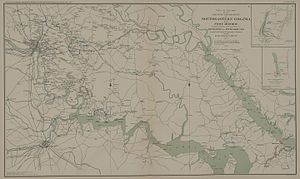| Peninsula campaign | |||||||
|---|---|---|---|---|---|---|---|
| Part of the American Civil War | |||||||
 George B. McClellan and Joseph E. Johnston, respective commanders of the Union and Confederate armies in the Peninsula campaign | |||||||
| |||||||
| Belligerents | |||||||
| United States | Confederate States of America | ||||||
| Commanders and leaders | |||||||
| George B. McClellan |
Joseph E. Johnston Gustavus Woodson Smith Robert E. Lee John B. Magruder | ||||||
| Units involved | |||||||
| Army of the Potomac | Army of Northern Virginia | ||||||
| Strength | |||||||
|
| |||||||
| Casualties and losses | |||||||
| 23,119[7] | 29,298[7] | ||||||


The Peninsula campaign (also known as the Peninsular campaign) of the American Civil War was a major Union operation launched in southeastern Virginia from March to July 1862, the first large-scale offensive in the Eastern Theater. The operation, commanded by Major General George B. McClellan, was an amphibious turning movement against the Confederate States Army in Northern Virginia, intended to capture the Confederate capital of Richmond. Despite the fact that Confederate spy Thomas Nelson Conrad had obtained documents describing McClellan's battle plans from a double agent in the War Department, McClellan was initially successful against the equally cautious General Joseph E. Johnston, but the emergence of the more aggressive General Robert E. Lee turned the subsequent Seven Days Battles into a humiliating Union defeat.
McClellan landed his army at Fort Monroe and moved northwest, up the Virginia Peninsula. Confederate Brigadier General John B. Magruder's defensive position on the Warwick Line caught McClellan by surprise. His hopes for a quick advance foiled, McClellan ordered his army to prepare for a siege of Yorktown. Just before the siege preparations had been completed, the Confederates, now under the direct command of Johnston, began a withdrawal toward Richmond. The first heavy fighting of the campaign occurred during the Battle of Williamsburg in which the Union troops managed some tactical victories, but the Confederates continued their withdrawal. An amphibious flanking movement to Eltham's Landing was ineffective in cutting off the Confederate retreat. During the Battle of Drewry's Bluff, an attempt by the US Navy to reach Richmond by way of the James River was repulsed.
As McClellan's army reached the outskirts of Richmond, a minor battle occurred at Hanover Court House, but it was followed by a surprise attack by Johnston at the Battle of Seven Pines or Fair Oaks. The battle was inconclusive, with heavy casualties, but it had lasting effects on the campaign. Johnston was wounded by a Union artillery shell fragment on May 31 and replaced the next day by the more aggressive Robert E. Lee, who reorganized his army and prepared for offensive action in the final battles of June 25 to July 1, which are popularly known as the Seven Days Battles. The result was that the Union army was unable to enter Richmond, and both armies remained intact.
- ^ ORA 11(3), 184
- ^ ORA 11(3), 238
- ^ ORA 11(3), 312; Further information: Official Records, Series I, Volume V, page 13.
- ^ Newton, Joseph E. Johnston and the Defence of Richmond, Appedix 2
- ^ Harsh, Confederate Tide Rising, Appendix 2C
- ^ ORA 11(3), 645
- ^ a b Livermore, Numbers and Losses in the Civil War, various pages